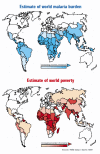Social implications of malaria and their relationships with poverty
- PMID: 22973492
- PMCID: PMC3435125
- DOI: 10.4084/MJHID.2012.048
Social implications of malaria and their relationships with poverty
Abstract
In poor countries, tragically, people die unnecessarily. Having changed our understanding about issues related to poverty, even in the fight against malaria we must keep in mind a number of issues other than simple lack of economic resources. In this article we tried to discuss the various aspects that make malaria a disease closely related to poverty and the effects of malaria on the same poverty of patients who are affected. If you want the program to "Rool Back Malaria" to succeed, you must program interventions that improve the living conditions of populations in endemic area, individually and as communities. As has become clear that the discovery of an effective vaccine will not eradicate the disease, remains a fundamental understanding of mechanisms related to poverty that cause Malaria remains one of the major killers in the world, to help communities affected and individuals to prevent, cure properly and not being afraid of this ancient disease.
Figures



References
-
- WHO. Final report of the Commission on Social Determinants of Health. WHO; 2008. Publications and documents: “Towards health-equitable globalization: rights, regulation and redistribution”.
-
- WHO. A Sourcebook for Health Professionals (Module on Malaria) WHO; 2006. Publications and documents: “Integrating Poverty and Gender into Health Programmes”.
-
- WHO. World Malaria Report. 2011.
-
- WHO. World Malaria Report. 2009.
LinkOut - more resources
Full Text Sources
Research Materials

